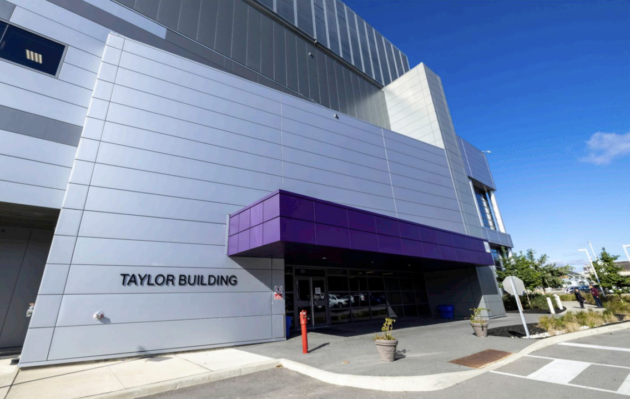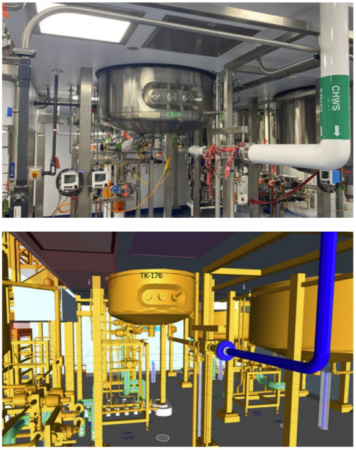
Designing Sanofi’s new vaccine facility in Toronto
André Voshart
Fluid Power Medical Machine BuildingSanofi’s new vaccine manufacturing facility pushes design boundaries with digital integration and advanced modelling.

As Canada’s largest biomanufacturing facility, it will significantly increase Sanofi’s capacity to produce pediatric and adult vaccines for diseases like pertussis, diphtheria and tetanus. (Credit: Sanofi)
Global healthcare company Sanofi opened a new state-of-the-art vaccine manufacturing facility at its Toronto campus this past spring. As the largest biomanufacturing facility in Canadian history, this facility will significantly increase Sanofi’s capacity to produce pediatric and adult vaccines for diseases like pertussis, diphtheria and tetanus. These vaccines will be exported to more than 60 global markets, enhancing health protection both in Canada and internationally.
This new facility is part of Sanofi’s ongoing investment in Canada’s biomanufacturing sector, representing a total investment of more than $800 million, supported by federal, provincial and municipal governments. François-Philippe Champagne, the federal minister of innovation, science and industry, called this “a significant milestone in our vision to rebuild our domestic biomanufacturing sector,” emphasizing that it will help Canada be better prepared for a range of health threats—including future pandemics.
What type of design considerations went into the development of this cutting-edge facility? Design Engineering spoke with Jan Lutzen, head of engineering and technical services at Sanofi, to learn more about the innovative features and strategies behind the new facility.
Ready for the future
Lutzen emphasizes that, when starting to design a facility like this, “you have to think of the future” to ensure long-term success.
One of the primary considerations during the design phase was to understand and optimize the entire production process. With manufacturing entering the era of Industry 4.0—where digital integration is transforming manufacturing at an unprecedented level—Lutzen highlights the need to prepare for this shift by building a smart facility designed for the future.
The design of the facility’s equipment and digital components were developed in parallel. “Understanding and defining your equipment, and integrating that with automation, allows you to design specifications around what your digital infrastructure needs to look like,” Lutzen says. In this facility, even the digital aspects were designed from the ground up, ensuring that every element was aligned with the overall vision of a smart factory.
With a life-cycle expectation of 40 years, he underscores the forward-thinking approach: “Smart factories are the future.”
Once the digital layers of the facility were established, selecting the right partners became essential. This involved establishing clear protocols from an IT perspective to guarantee all components could work seamlessly together.

During the design phase, the Sanofi engineering team made sure they had the right tools to optimize every aspect of the facility. (Credit: Sanofi)
Designing for the space
During the design phase, Lutzen and his team made sure they had the right tools to optimize every aspect of the facility. “We have 22 meters of height to work with, where we need to fit pipes, equipment and information,” he explains. It was important to maximize density and optimize the ergonomic and process flows. The team achieved this through 3D modelling, which let them extract 2D renderings and optimize the space between skids.
He also emphasizes the importance of rightsizing each “unit operation” (i.e. the discrete step in a process where a specific function is performed) in relation to the next—a concept that is often underestimated by engineers. “It’s about creating scalability,” he says.
By focusing on these aspects up front, Lutzen and his team were able to achieve near-perfect alignment in the design, making sure each component of the process worked harmoniously with the others.
There are three 4,000-litre fermenters in the middle of the facility, which are crucial to the manufacturing process. Without the use of 3D modelling, he says, fitting these huge structures into the layout would have been difficult. Advanced modelling made this possible and ensured that the integration was seamless, facilitating optimal flow.
Maintenance accessibility
Lutzen also highlights an aspect that often doesn’t receive much attention: serviceability. “Above our equipment, we have a walkable ceiling,” he reveals, which allows maintenance teams to access all necessary equipment and sensors without entering the clean space, thanks to an interstitial space. This design enables maintenance to be performed with minimal downtime and without compromising the cleanliness of the facility.
Reflecting on his extensive experience in the pharmaceutical industry, Lutzen notes, “I’ve been in the pharma industry for more than 20 years, and maintenance accessibility was often an afterthought.”

It was critical to maximize density and optimize the ergonomic and process flows. (Credit: Sanofi)
Enhanced data and monitoring
The Toronto facility also made a large investment in automation, incorporating a manufacturing execution system that monitors around 28,000 data points. This data infrastructure aligns with both the manufacturing and facility infrastructure, ensuring a truly smart factory. “Technology has advanced to the point where sensors now have chips in them,” Lutzen adds.
By having detailed data on hand, the facility is not only built for future needs but also ensures that every batch meets the required standards.
When issues arise, this data can pinpoint where things have gone wrong, which is particularly valuable during the development phases.
“Data is a really powerful troubleshooting tool,” Lutzen says.
For example, during engineering batches, they encountered performance challenges and were unsure why a particular process step wasn’t working as intended. With the help of their data science team, they conducted a thorough analysis and identified a shift in data that correlated with changes in a few components.
“It removed the guesswork and experimentation,” Lutzen says. Within a few days, the data science group was able to pinpoint the cause of the issue, demonstrating the power of leveraging digital capabilities in a smart facility. “The smart factory is there to ensure issues are quickly resolved,” he adds.
Investments were made in monitoring and predictive equipment, utilizing the wide array of sensors to monitor the state of machinery. “We identified all those parts that make the process successful and monitored them,” he explains. This allows personnel to proactively address potential issues before they lead to failures. “We’re just beginning to experiment with what this means for a facility,” he adds.
Safety in a closed-loop system
Lutzen also emphasizes its closed-system approach, which provides enhanced protection for both equipment and operators. Although there are still protocols and requirements around personal safety, this design reduces risks and streamlines operations.
There are challenges in creating a fully closed manufacturing process. While it may sound simple, the reality is far more complex. “There are a lot of things humans do regularly, and transitioning those tasks to automation requires careful planning and supervision,” he says. To achieve this, it was necessary to build out the logical steps that automation will follow, ensuring that each action is carried out precisely as intended. “The level of complexity in a fully closed system is very, very high,”
One advantage is the facility’s ability to automate transfers between each unit operation. “This means you don’t have employees doing these manual transfers,” he says, pointing out that automation takes on the grunt work, allowing the workforce to focus on higher-value tasks.
Lutzen and his team were also committed to not only meeting but exceeding regulatory requirements. “We’re global, so we take the most stringent of regulations across the world,” he says. By adopting this rigorous approach, the facility ensures it meets (or surpasses) safety and standards regulations, reinforcing its commitment to operational excellence and the well-being of its employees.
Sustainability
Lutzen also emphasizes the importance of sustainability in the design and operation of the facility, aligning with their global sustainability initiative—Planet Care—which aims for net-zero emissions by 2045.
A key part of this initiative is incorporating energy-efficient design elements to reduce the facility’s carbon footprint. “We have incorporated LED lighting and motion sensors, as well as heat recovery systems to minimize energy use and recapture heat,” he explains. This commitment to sustainability is also reflected in the facility’s certifications, as it meets ISO 14001 and 50001 standards, ensuring a continuous improvement loop in environmental and energy management.
Another sustainability feature is the facility’s wastewater treatment and reuse plant, which lets them capture and reduce water consumption by 20 per cent. Additionally, the facility has invested in efficient boilers to service its needs, further contributing to the reduction of energy consumption and overall environmental impact.
Commissioning
To ensure everything functions as designed, the facility is currently undergoing a comprehensive commissioning and qualification process. This includes in-field verification, where each circuit and loop undergo function testing. By conducting thorough testing, Lutzen and his team can confidently confirm that the system is operating correctly, maintaining the high standards required for a fully automated, closed manufacturing environment.
But he is excited about the process so far. “We’re so proud of this facility, that we as a team at Sanofi were able to do this.”
Print this page
Advertisement
<
